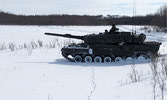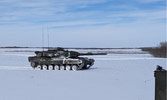EX STEELE LANCE DRY TRAINING
WO Collier
Exercise Steele Lance saw B Squadron deploy to Wainwright Alberta to complete a multitude of training objectives. Starting with the Leopard 2 gunnery/drivers Primary Combat Function (PCF) courses, completing squadron level 1 and 2 live fire ranges, small arms ranges, winter survival training, and ending with troop level dry training in preparation for the upcoming Exercise MAPLE RESOLVE and future level 3 ranges.
With the completion of the ranges, the squadron transitioned into the dry training portion which saw second troop first in the breach. Under the watchful eyes of both the squadrons, regimental leadership and the Colonel Commandant General (Ret’d) W.J. Natynczyk, CMM, MSC, CD second troop departed range 25 and conducted a troop level advance to contact. The soldiers were ecstatic to finally have the opportunity to go and conduct training on the vehicles. This was the first time in months and, for most of the troop, the first timing training in their new positions. This portion ended with the conduct of a troop shoot on the acting enemy force, the Colonel Commandant’s vehicle. Then, the troop moved back to the range to hand the vehicles over to first troop for their day of training. The next iterations started with the troop leaders receiving orders and departing to conduct withdrawals under the control of OC B Maj Shumka. In conjunction with the OC, there was a robust opposing force of snowmobiles lead by Capt Hume and an indestructible but always stuck Lav 6 with Squadron Sergeant Major B Squadron.
After completion of the withdrawal, the troops had the opportunity to conduct other tasks such as hasty attacks and going through a running replenishment (RR). During this RR, the troops quickly learned about the challenges of refueling tanks, each with 40 jerry cans prior to moving into troop hides for the night and conducting nighttime navigation. Despite all the constraints and issues B Sqn faced, high quality training was completed, and all soldiers were happy to get the time on tanks to do their jobs.





